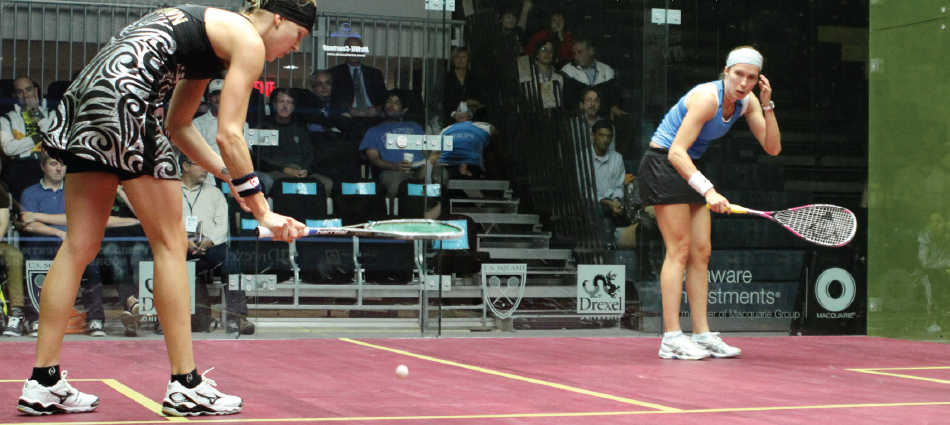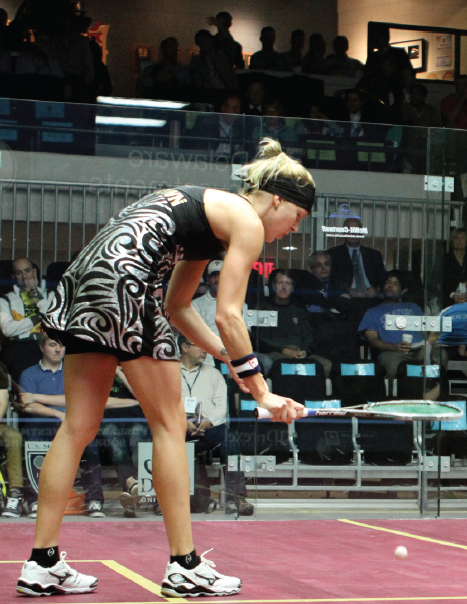
By Richard Millman, Owner – The Squash Doctor Corporation
As we have often heard, the serve is the one time in a game when we have absolute control over how and when to hit the ball. In effect the best opportunity we’re ever going to get to gain ‘an edge.’ So how best to achieve that edge?
First and foremost, as I said in a recent article, Squash is a game of movement. So when you consider your serve, consider first where you would like to be by the time you finish your serve and organize your movement to that end. Then design your serve to facilitate that movement into position for your next shot.
To achieve this you need to consider how much time you want in order to be in position and, therefore, what pace you need to strike the ball. You can move quickly or slowly as long as the speed you hit the ball doesn’t give you less time to get into position than the time it takes the ball to get to your opponent. It is absolutely imperative that you are in position and ready to move on to the opponent’s return BEFORE the ball gets to their racquet. Just by being in position and letting the opponent know that you are there, ‘lurking’, can make the opponent change their choice of shot to a more defensive option, thereby strengthening your control of the rally by giving you more time or by pressuring them into trying to make an attacking shot ‘too’ good, thereby producing an error.
Most experienced players develop a service ritual—a set pattern of behavior that can be repeated precisely time after time. This is a very good idea provided that it follows the rules of time management that I outlined in the paragraph above.
You might call this your stock or standard serve. For many people their standard serve is a lob from their forehand side and a flatter ‘hammer’ serve from their back-hand side.
This is a good beginning provided you are practicing the movement into position as well as the striking of the ball. A very good drill is to hit 50 of your standard serves, moving with your own shot through the position that you would take to retrieve/attack the next shot (normally in the middle of the court or slightly to your opponent’s side if your serve is extremely accurate) before moving back with the ball to gather it as it bounces in the back corner. Then, still jogging, return to the service box and repeat the operation until you have done 50.
Not only will this drill develop consistency in your standard serve ritual, it will help you develop your innate peripheral sense of the court and your immediate surroundings—a personal mental blueprint of your playing environment if you will.
You should also develop up to four or five simple variants of your standard serve. The most common ones in addition to the basic lob are: the hammer serve (hard at eye level), the body serve down the middle, the backhand serve from the forehand/forehand serve from the backhand, the low hammer (aimed low at the sidewall at ankle level).
Your opponent subliminally reads cues from your behavior, whether they realize it or not. If they have not been trained to recognize this (which few have in my experience), it leads to an automatic tendency to make assumptions about the nature of the way that you are about to serve based on your perceived body language. If your body language display can be trained to show consistent cues, but then you change the actual delivery, you can gain a considerable edge by eliciting a mistimed shot from your opponent. In baseball or softball this is known as a ‘change up’ and often results in a ‘whiff.’ While ‘whiffs’ do happen in Squash, the more likely outcome is a slightly misdirected ball which affords you an opportunity to take control of the rally from the outset.
To develop this skill, first practice your four or five basic standard and variation serves until you can deliver them identically with time efficient positioning—for instance, lob ritual with hammer delivery. Then practice offering one of the pre-serve body languages with the delivery of an opposite speed serve.
Work hard on practicing both the straight delivery and the ‘change up’ and you will bamboozle your opponents, reducing their confidence levels and delivering that all important ‘edge’ to you!


